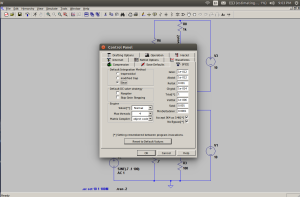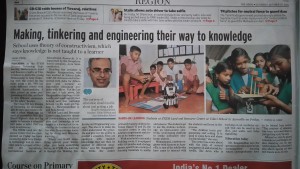When your simulation can’t complete and ends unexpectedly….. go to the Simulate/ control panel/Spice .. and change the default integration method to “GEAR” and things should run fine..
The Hindu article about the STEMLAND
Making, tinkering and engineering their way to knowledge
School uses theory of constructivism, which says knowledge is not taught to a learner
At the STEM (Science Technology Engineering Mathematics) Land and Resource Centre at Udavi School in Auroville, young Hemasundar is busy tinkering with the robot he has made using a kit. “We can make different robots with different functionalities . I have picked up some programming with this, and how to give different commands for the robot,” he says.
The class-VII boy dreams of becoming an archaeologisit, he says, and wants to design a robot which can used at excavation sites. His friend Vignesh adds that he wants to become a scientist, and make a robot that can help in astronomy.
The STEM Land and Resource Centre that was inaugurated on Friday has been created by Aura Auro Design (a technology unit in Auroville) and is a project of SAIIER (Sri Aurobindo International Institute of Educational Research). It is supported by the Bengaluru based comapany, Aura Semiconductor.
Heading the initiative is Sanjeev Ranganathan, who has worked at Silicon Labs, NXP, ST-Ericsson and volunteered with Asha for Education and worked on innovative education projects with them. For the last two and half years, Mr. Ranganathan has been in Auroville and teaching Isai Ambalam School. On his team are Vaidegi G., Sundranandhan K. and Bala Anand.
STEM Land and Resource Centre takes from the theory of Constructivism, which implies that knowledge is not taught to a learner but recreated by the learner on his or her own. It encourages learning by doing and discovery learning.
“When you build something outside your knowledge, you learn something better. At STEM, the learning is through the ‘Making, Tinkering, and Engineering’ concept. The idea is to make the child understand the principle and give her the ability to predict a situation. They are equipped with implicit knowledge that can be applied to different situations,” says Mr. Ranganathan. While the centre primarily targets children between class VI and IX, the resource centre is also for adults to experiment and create at its ‘maker space.’
With a material room and a building room, it is equipped with 150 puzzles and strategy games, apart from variety of learning materials in maths and science. The students get to use the Arduino technology, an Open-source electronic prototyping platform to create interactive electronic objects.
Maniyammai, a system engineer with Saracon in Auroville, is one of the adults who have come to interact with the students and learn in the process.
“The children learn programming and coding. It is good to come here and share our knowledge,” she says.
The center has come about with help of several youngsters in and around Auroville, like Arun who is working on an oscillator circuit that can be used in radios, and audio and video signalling.
Education today
Mr. Ranganathan says the present education system has oversimplified learning where undergraduates have to be trained from scratch. “The purpose of education has been narrowed down to just getting a job,” he says.
Education must be geared towards not just fitting in, but also standing out, he says. And in Auroville, education is also about figuring out what one wants to do, he adds.
“The purpose of education should not be about just getting a job”
Sanjeev Ranganathan, teacher, Udavi School and Isai Ambalam School

Getting ‘officially’ started in STEMLAND
The inauguration of STEMland has just happened. It feels good to be part of something different and useful for children as well as adults who are into math, technology, electronics etc… Over the past month and a half STEMland has given me the space and opportunity to learn and grow with the children. This process of learning(peer learning) in STEMland will always grow as I think there is enough scope there. This place should get well used and benefit everyone related to STEMland!
Timer in Python
I encountered a situation where I had to check if a function is running for a certain time. The below method called ‘after’ was very useful. This registers an alarm callback that is called after a given time.
Syntax : after(delay_ms, callback=None, *args)

